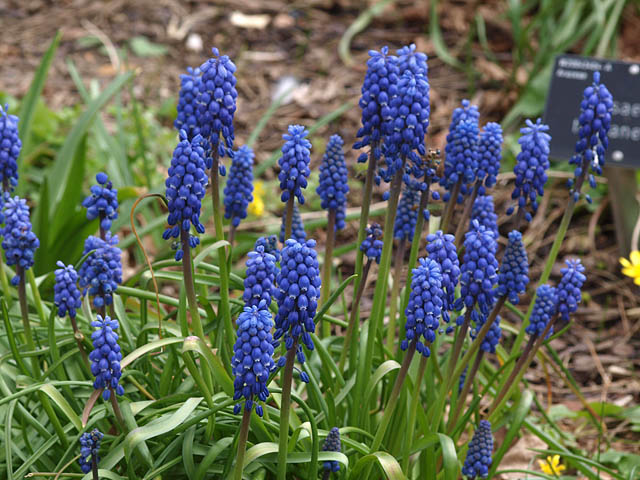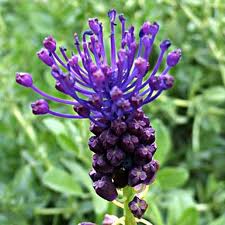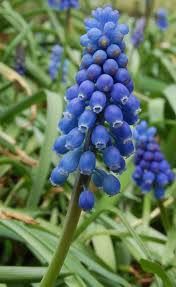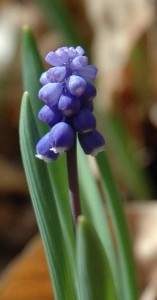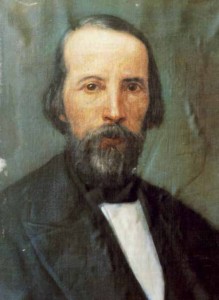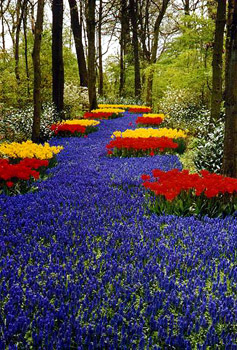There are dozens of edible species that are wild in Europe and cultivated or escaped in North America. Three related species with a multitude of names are quite popular in Europe but relatively unknown in North America though they grow there and are used in similar ways with some variation. They are the Tassel Hyacinth, the Musk Hyacinth and the Grape Hyacinth.
The Tassel Hyacinth, Leopoldia comosa, is used extensive particularly in Italian and Greek cooking. The bulbs are boiled then pickled or preserved in oil. They are thought to stimulate the appetite and are also diuretic. Interestingly wild ones are preferred over cultivated ones. It is “officially” found — read on United States Department of Agriculture maps — in Pennsylvania, Maryland, Virginia, both Carolinas, Georgia, Tennessee, Kentucky, Ohio, Illinois, Missouri, Oregon and Washington state. They, like the other species here, can be found elsewhere but have not made the official USDA list. The Tassel Hyacinth naturalizes easily and can become invasive. It’s native from southeastern Turkey to Iran but was in the British Isles by the 1600s. Its flower stalk is up to two feet tall, pale brown urn-shaped fertile flowers on the lower half, blue flowers on the upper half. The blue flowers on top, pollinated by bees, resemble a tassel, hence the name. Depending upon the climate it flowers in mid-spring. In Greece it is called βολβοί (vol-VEE) literally “bulbs.” The Italians call them “lampascioni”, “lampasciuni” and “lamponi.” Leopoldia, (leo-POL-di-ah) honors of Leopold II, Grand Duke of Tuscany (1797 – 1870.) Comosa (kom-OH-suh) means “hairy”
The Musk Hyacinth, Muscari neglectum, is used in a similar way but has urn-shaped blue blossoms. The blossoms are used as flavoring in Europe. The bulbs are also boiled then eaten. More so it was planted as a source of starch for ironing clothes. It is found in the eastern United States from southern New England to west to Michigan south to Florida then west to New Mexico. The species has had a lot of botanical drift and over the years nearly four dozen different names. The species grows in clumps to about a foot high, in full sun to partial shade, has a raceme of blue urn-shaped blossoms in the spring, Actually the lower blossoms are dark blue to black blue and the upper blossoms are brilliant bright blue. In Spain it is a favored blossom under olive trees. Muscari (mus-KAH-ree ) is from Greek and means Musk. Neglectum (nay-GLEK-tum ) mean “slight” or “overlooked.”
Blossoms of the Grape Hyacinth (Muscari botryoides) are also picked. They and the buds are pickled. It is naturalized in North America in a patchwork of areas including the eastern U.S. and Canada, the Pacific coast of the U.S. and Canada plus Texas, Utah and Nebraska. The high plains states and the desert southwest are left out as is South Carolina, Georgia, Florida and Louisiana. Like the other members of group the stems grow from an underground bulb. Leaves are basil, linear, hairless, grooved or “U” shaped in cross section. Flowers are a dense, terminal raceme, urn-shaped, blue. Again Muscari (mus-KAH-ree) means Musk and botryoides (bot-ree-OI-deez) means in clusters like grapes.
The bulbs of the edible species are slightly bitter because of saponins, basically plant soap which is why cooking the bulbs is necessary if not changing the water once or more.
I cannot find a declarative statement why Leopold II, the last reigning Grand Duke of Tuscany, was honored by the genus. Leopoldia was established by the Italian botanist Filippo Parlatore (1816 – 1877.)
Leopold was Palatore’s patron, gave him the position of professor of botany and made him director of the botanical garden in Florence… good enough reason to have a genus named after you. The grand duke was also a founding patron of L’Istituto Statale della Ss. Annunziata, the first female boarding school in Florence for well-born ladies. To his credit he also commissioned large public works and was the first to promote tourism to Tuscany.

